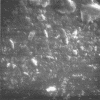A subinhibitory concentration of clarithromycin inhibits Mycobacterium avium biofilm formation
- PMID: 15561879
- PMCID: PMC529245
- DOI: 10.1128/AAC.48.12.4907-4910.2004
A subinhibitory concentration of clarithromycin inhibits Mycobacterium avium biofilm formation
Abstract
Mycobacterium avium causes disseminated infection in immunosuppressed individuals and lung infection in patients with chronic lung diseases. M. avium forms biofilm in the environment and possibly in human airways. Antibiotics with activity against the bacterium could inhibit biofilm formation. Clarithromycin inhibits biofilm formation but has no activity against established biofilm.
Figures



References
-
- Aksamit, T. R. 2002. Mycobacterium avium complex pulmonary disease in patients with pre-existing lung disease. Clin. Chest Med. 23:643-653. - PubMed
-
- Bermudez, L. E., C. B. Inderlied, P. Kolonoski, M. Petrofsky, P. Aralar, M. Wu, and L. S. Young. 2001. Activity of moxifloxacin by itself and in combination with ethambutol, rifabutin, and azithromycin in vitro and in vivo against Mycobacterium avium. Antimicrob. Agents Chemother. 45:217-222. - PMC - PubMed
-
- Bermudez, L. E., C. B. Inderlied, P. Kolonoski, M. Wu, P. Aralar, and L. S. Young. 2001. Telithromycin is active against Mycobacterium avium in mice despite lacking significant activity in standard in vitro and macrophage assays and is associated with low frequency of resistance during treatment. Antimicrob. Agents Chemother. 45:2210-2214. - PMC - PubMed
Publication types
MeSH terms
Substances
Grants and funding
LinkOut - more resources
Full Text Sources
Medical

